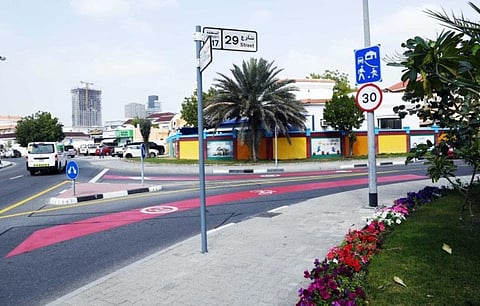Dubai ‘soft mobility’ plan for residential areas gets underway
Cycling tracks, shaded paths, landscaping, rest areas part of new RTA project

Dubai: The initial phase of a new ‘soft mobility’ masterplan has started in Dubai, facilitating walking, cycling or e-scooters in Karama, Mankhool and Al Qusais 1.
The announcement came on Saturday in a statement from Mattar Al Tayer, director-general and chairman of the board of executive directors of Dubai’s Roads and Transport Authority (RTA).
The plan’s initial phase, which will be completed in March, “addresses first and last-mile challenges by providing an infrastructure that supports the integration of mobility such as the construction of cycling tracks, pedestrian crossings and rest areas, shaded paths, landscaped areas, parking for rented cars and bike racks”, said Al Tayer.
The project works will continue next year will cover Barsha 1 and 2, Bateen, Baraha, Al Ras, Al Qusais 2 and Al Qusais Industrial. The number of covered areas by the flexible transport plan is set to increase to 27 by 2024.
Care-free mobility study
RTA has commissioned a comprehensive car-free mobility study in Dubai, which focused on providing an infrastructure suitable for relatively long and medium journeys to ensure safe and smooth transport for all. It sets a strategy for promoting the use of non-motorised transport modes, people-friendly infrastructure and facilitating easy access for people of determination.
It also aims to connect various city components by easing mobility between developed and catchment areas. It addresses the needs of the first and last-mile challenge by using non-motorized modes like walking and biking. The plan sets guidelines for fostering the integration of transit means and implementation across RTA projects.
Transport integration
The Soft Mobility project entails providing integrated transport elements such as serving the mobility of people of determination, constructing elevated pedestrian crossings and speed-calming devices, designating shared biking lanes, and providing bike racks as well as directional and cautionary signage.
Elements also include the construction of adjusted pavements, routes shared by vehicles and non-motorised means, rest areas including landscaped and sitting places and shaded paths to encourage people to use flexible mobility means.
Criteria
The selection of areas for implementing the flexible mobility project was based on several parameters namely, availability of existing RTA projects, availability of public transit means, a high number of users, and population density. The selection criteria also considers the type of land use (residential, commercial or mixed), the condition of the existing pavements and pedestrian walkways, availability of shaded elements as well as crossing and biking facilities, and RTA’s 5-Year Plan for cycling tracks.
Mobility elements
Under the initial phase of the project covering three residential areas (Karama, Mankhool and Al Qusais 1), RTA constructed 314 elevated pedestrian crossings and 66 speed-calming devices. It designated shared pedestrian and biking lanes extending 33km and shared routes for vehicles and non-motorised flexible transit means extending 52km. It also added 2,000 directional or cautionary signs, adjusted 77,000 square meters of pavements, built 21 rest areas and seven shaded routes.
The project involves the launch of ‘Friendly Safe Streets’, a new concept in Dubai that had been implemented for the first time in a small German city and the concept spread across Europe. It envisages the introduction of safe school zones, implementing speed-calming devices and safe crossings for pedestrians and cyclists at junctions together with seamless pavements. It also increased landscaped and shaded areas and seats to ensure smooth and integrated mobility in Dubai.
Sign up for the Daily Briefing
Get the latest news and updates straight to your inbox







